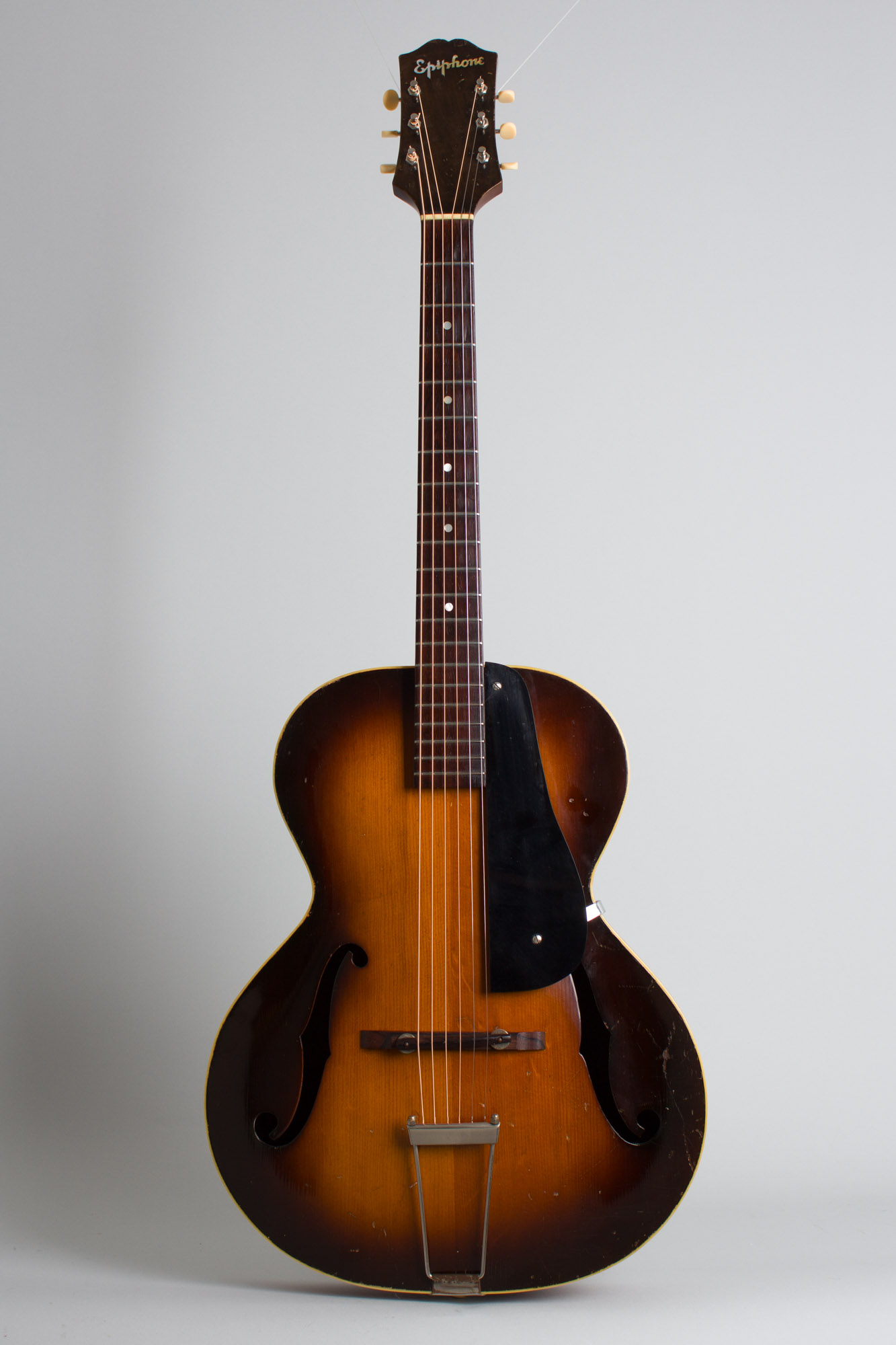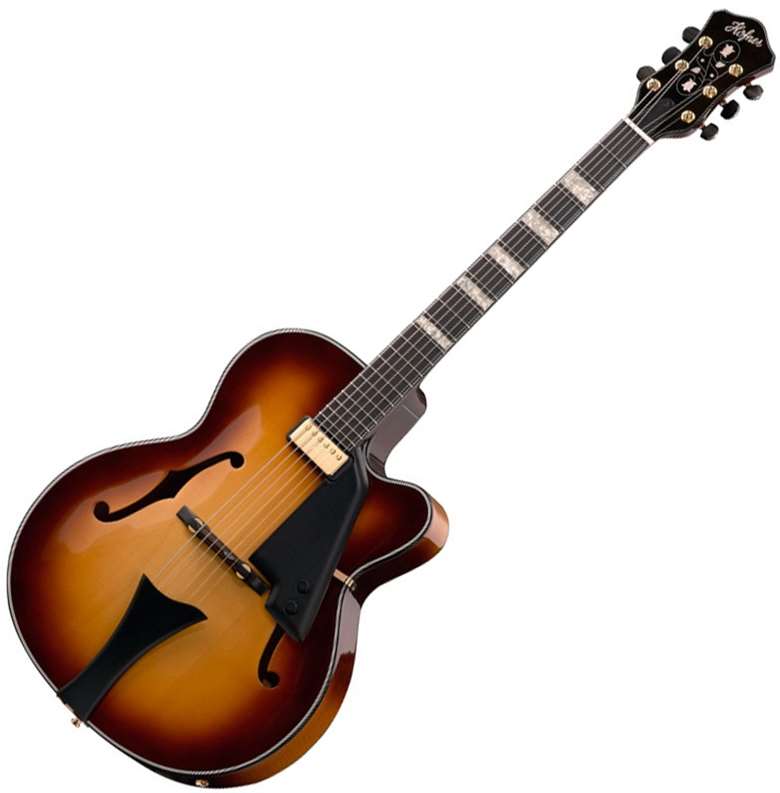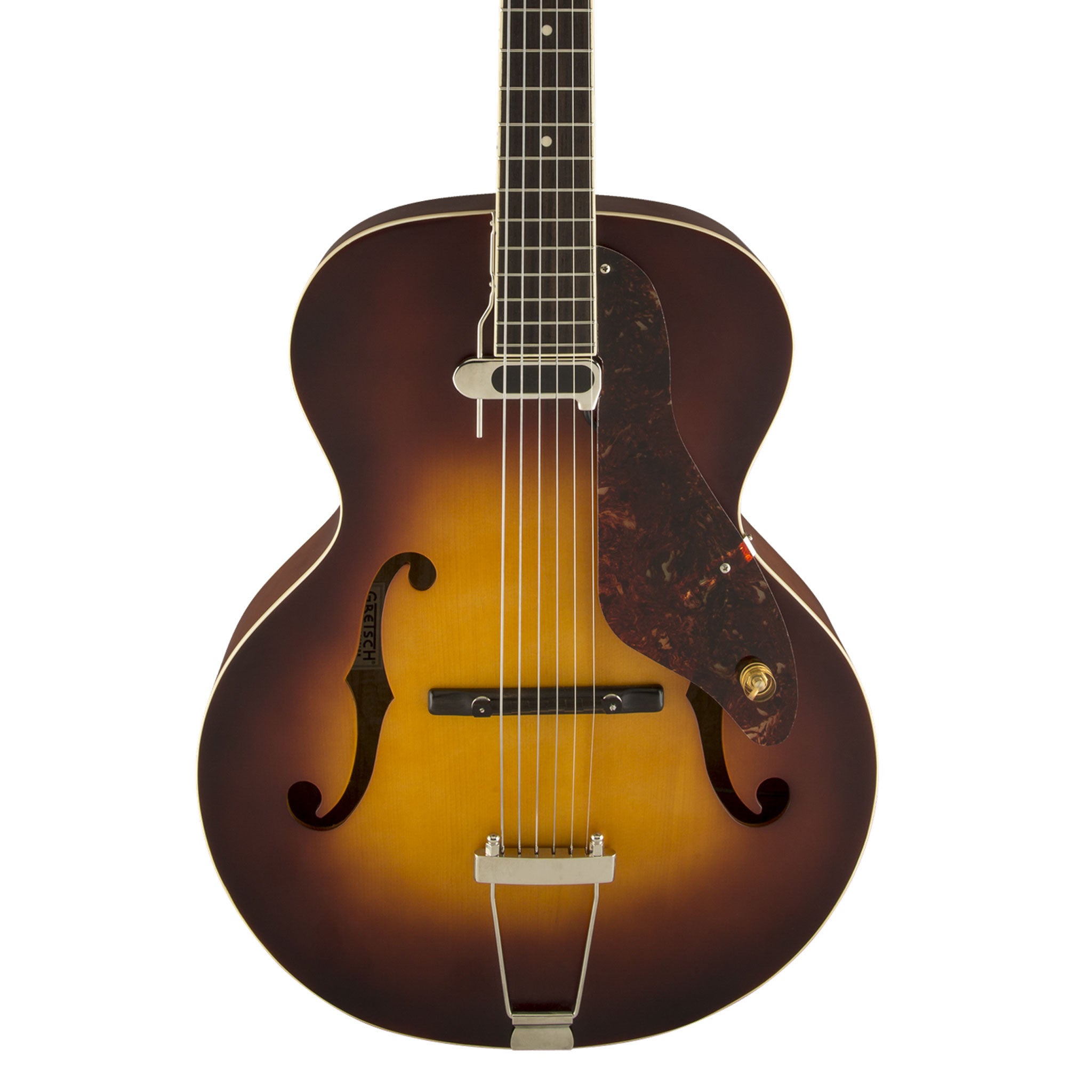Who paired his arch top guitar after the violin? The answer is Lloyd Loar.
Lloyd Loar was a pioneering luthier. He worked for Gibson in the early 1920s. Loar is known for his innovative string instrument designs. He combined elements of the violin with the arch top guitar. This blend created a unique, rich sound.
Loar’s ideas changed guitar design forever. His work still influences modern luthiers. In this blog, we’ll explore Loar’s journey. We’ll learn how his violin knowledge shaped his guitar designs. And we’ll see why his creations remain iconic. Dive in to discover the genius behind the arch top guitar’s evolution.

Credit: www.retrofret.com
Introduction To Arch Top Guitars
Arch top guitars have a unique charm. They combine the beauty of violins with the sound of guitars. These instruments have a distinct shape and design. Musicians love their rich, full sound. They are popular in jazz and blues music. Let’s dive deeper into their history and unique features.
History And Origins
The arch top guitar has an interesting history. It was inspired by the violin’s design. Orville Gibson, a talented luthier, created the first arch top guitar in the 1890s. He wanted to improve the guitar’s sound and volume. His design featured a carved top and back. This helped to produce a louder and clearer sound. Gibson’s innovative design was a huge success. Soon, other luthiers adopted his ideas.
By the 1930s, arch top guitars became very popular. Jazz musicians loved them for their warm tones. They were also used in big band music. The famous Gibson L-5 model was a favorite among players. Over the years, many brands created their own versions. Each had its unique touch, but the core design remained the same.
Unique Features
Arch top guitars have several unique features. Their most distinct feature is the arched top and back. This design improves sound projection and volume. They also have F-holes, similar to violins. These F-holes allow the sound to resonate more freely.
Another unique feature is their floating bridge. Unlike flat top guitars, the bridge is not glued down. This allows for better sound transmission. The tailpiece is also different. It is usually made of metal and attaches to the guitar’s end. This design adds sustain and resonance to the sound.
Many arch top guitars have a cutaway design. This makes it easier to reach higher frets. The neck is often wider and flatter. This provides more room for fingerpicking. These features make arch top guitars perfect for complex jazz chords. They are also great for solo performances.

Credit: www.jazzwise.com
Influence Of The Violin On Guitar Design
The influence of the violin on guitar design is undeniable. Many luthiers looked to the violin for inspiration. This led to the creation of the arch top guitar. This design revolutionized guitar construction. Let’s explore how the violin shaped the guitar.
Early Inspirations
Early guitar makers admired the violin’s shape. They noticed its curved body. This design allowed for better sound projection. They wanted to replicate this in guitars. The arch top guitar was born from this desire.
Violin makers like Antonio Stradivari inspired guitar luthiers. Stradivari’s techniques were legendary. His attention to detail set a high standard. Guitar makers adopted these methods. They aimed to create instruments with similar quality.
Shared Characteristics
The arch top guitar and violin share many traits. Both have curved tops and backs. This design enhances sound quality. It helps the instrument resonate better. The F-holes on arch top guitars mimic those on violins. They allow sound to escape.
Both instruments use similar wood types. Maple and spruce are common choices. These woods provide a rich tone. They are also durable. This ensures the instrument lasts a long time. The craftsmanship of both instruments is meticulous.
Lloyd Loar: The Pioneer
Lloyd Loar stands out as a monumental figure in the history of string instruments. He is renowned for his innovative work with Gibson, where he applied his deep understanding of the violin to the arch top guitar. This pioneering move changed the world of guitar design forever.
Biography Of Lloyd Loar
Lloyd Loar was born in 1886 in Cropsey, Illinois. He exhibited an early interest in music and engineering. His fascination with string instruments led him to study at Oberlin Conservatory. Loar joined Gibson in 1919, bringing a fresh perspective to their designs.
His tenure at Gibson was marked by significant innovations. Loar’s background in acoustics and violin construction influenced his approach to guitar design, leading to revolutionary changes in the industry.
Contributions To Guitar Design
Loar’s most notable contribution was the F-5 mandolin. This instrument featured F-holes instead of the traditional oval hole. The F-holes improved sound projection and tonal quality, making it a favorite among musicians.
In addition, Loar introduced the L-5 guitar. This guitar also featured F-holes, an elevated fingerboard, and an adjustable bridge. These changes allowed for better sound resonance and playability.
- F-5 Mandolin: Enhanced projection, better tone.
- L-5 Guitar: Improved resonance, elevated fingerboard, adjustable bridge.
Loar’s designs emphasized the importance of fine-tuning the instrument’s structure to enhance its acoustic properties. His work continues to influence modern luthiers and guitar makers.
Loar left Gibson in 1924 but his legacy lives on. His innovative designs paved the way for future developments in guitar making, solidifying his status as a pioneer in the field.

Credit: massstreetmusic.com
The Role Of Gibson In Guitar Evolution
The history of guitars is rich and complex. One name stands out: Gibson. Gibson has played a key role in shaping the evolution of guitars. Among their many innovations, the arch top guitar holds a special place. This guitar design was inspired by the violin.
Gibson’s Innovations
Gibson introduced many innovations in the world of guitars. Here are some key innovations:
- Arch top design: Inspired by the violin, it offers a distinct sound.
- F-holes: These enhance the guitar’s resonance and projection.
- Adjustable bridge: It allows for better intonation and action.
- Carved tops: They improve the instrument’s tonal quality.
Legacy Of Gibson’s Arch Top Guitars
The legacy of Gibson’s arch top guitars is profound. Musicians from various genres have used them. Here are some highlights:
- Jazz musicians: They love the warm, rich tones.
- Country artists: They appreciate the guitar’s resonance.
- Blues players: They value the instrument’s expressive qualities.
| Feature | Benefit |
|---|---|
| Arch top design | Distinct sound and aesthetics |
| F-holes | Enhanced resonance and projection |
| Adjustable bridge | Better intonation and action |
| Carved tops | Improved tonal quality |
Gibson’s arch top guitars continue to influence musicians today. Their design and sound set a high standard in the industry. The blend of innovation and tradition makes them timeless.
Comparing Arch Top Guitars And Violins
Comparing Arch Top Guitars and Violins can be fascinating. Both instruments share a rich history. They also have unique qualities that set them apart. While they look different, their craftsmanship and sound bear similarities. Let’s explore these aspects.
Construction Techniques
Arch top guitars and violins use carved tops and backs. Luthiers carve these from solid wood. This process enhances the sound. Violins often use spruce for the top. Maple is used for the back and sides. Arch top guitars also use these woods. Some modern guitars use laminated wood. This makes them more affordable.
The neck construction differs. Violins have a neck glued to the body. Arch top guitars have a dovetail joint or bolt-on neck. This affects the instrument’s playability. Both instruments have f-holes. These are the sound holes on the body. They help project sound. They also give the instruments a classic look.
Sound Differences
Violins produce a bright, clear tone. Their sound is very resonant. Arch top guitars have a warmer, richer tone. This is due to their larger body. The f-holes help shape the sound. Violins use a bow. This creates a continuous sound. Guitars use plucking or strumming. This gives a more percussive tone.
Different playing techniques also influence the sound. Violinists use vibrato and bowing techniques. Guitarists use fingerpicking and different strumming patterns. These techniques add to the unique sound of each instrument.
Impact On Modern Music
The pairing of the arch top guitar with the violin created a new sound. This blend has significantly impacted modern music. It introduced a fresh dynamic that influenced various genres. Let’s explore its impact on different musical eras.
Jazz And Swing Era
In the Jazz and Swing Era, the arch top guitar became a staple. Musicians like Django Reinhardt made it famous. They combined its sound with violins to create unique melodies.
- Enhanced rhythm sections
- Allowed for intricate solo performances
- Improved overall harmony
The arch top guitar provided the driving force in many jazz bands. Its bold sound complemented the violin’s smooth tones. This fusion gave birth to many classic jazz pieces still loved today.
Contemporary Use
Today, the arch top guitar and violin pairing continues to thrive. Modern artists use this combination in various genres. From indie to classical crossover, its influence is evident.
- Creates rich, layered textures in songs
- Adds depth to live performances
- Offers versatility in studio recordings
The arch top guitar’s adaptability makes it a favorite. Its sound blends well with the violin, offering a timeless quality. This pairing remains a crucial element in modern music production.
Notable Musicians And Their Arch Tops
The arch top guitar has been a favorite among many musicians. Its unique sound and design have made it a staple in various music genres. Let’s explore some of the famous guitarists who have mastered this instrument and their iconic performances.
Famous Guitarists
Several guitarists have become synonymous with the arch top guitar. Here are a few notable names:
- Wes Montgomery: Known for his smooth jazz melodies.
- Joe Pass: Revered for his intricate chord progressions.
- Charlie Christian: A pioneer in electric guitar playing.
Iconic Performances
Many performances have highlighted the beauty of the arch top guitar. These performances have left an indelible mark on music history.
| Guitarist | Performance |
|---|---|
| Wes Montgomery | “Full House” Live at Tsubo |
| Joe Pass | “Virtuoso” Solo Concert |
| Charlie Christian | With Benny Goodman Sextet |
The arch top guitar has played a central role in these performances. The musicians’ skills and the guitar’s unique sound have created unforgettable moments.
Future Of Arch Top Guitars
Lloyd Loar paired his arch top guitar after the violin, leading to rich, resonant tones. This innovative design influenced many modern stringed instruments.
The future of arch top guitars looks bright and full of potential. These guitars have captivated musicians for decades. They offer unique sounds and unmatched craftsmanship. As we move forward, the evolution of arch top guitars promises exciting changes. Let’s explore these possibilities.Innovative Designs
New designs continue to push the boundaries of arch top guitars. Luthiers experiment with different woods and materials. This results in varied tones and improved durability. Some guitars feature modern pickups and electronics. These advancements expand the versatility of the instruments. The blend of tradition and innovation keeps players intrigued.Continued Influence
Arch top guitars remain influential in various music genres. Jazz musicians cherish their warm, mellow tones. Blues players appreciate their rich sound and resonance. New generations of guitarists are discovering their charm. The timeless appeal of arch top guitars endures. Their legacy continues to shape the world of music.Frequently Asked Questions
Who Paired The Arch Top Guitar With Violin?
The arch top guitar was paired with the violin by Eddie Lang. Lang was a prominent guitarist in the 1920s.
Why Did Eddie Lang Pair Guitar With Violin?
Eddie Lang paired the guitar with the violin to create a unique sound. This pairing enhanced jazz music’s richness.
When Did Eddie Lang Popularize This Pairing?
Eddie Lang popularized the guitar-violin pairing in the 1920s. His innovative approach influenced many musicians.
What Genre Benefited From This Pairing?
Jazz music greatly benefited from Eddie Lang’s guitar-violin pairing. This combination added depth to jazz compositions.
Conclusion
The arch top guitar and violin share a unique connection. Both instruments have deep, rich sounds. Pairing these instruments showcases creativity and musical innovation. Musicians can explore new possibilities by blending their tones. This combination can inspire fresh, captivating music.
Understanding this link helps appreciate the beauty of musical evolution. So, whether you’re a guitarist or a violinist, consider experimenting. Discover the magic that happens when these instruments unite. It’s a journey worth taking for any music lover.
{ “@context”: “https://schema.org”, “@type”: “FAQPage”, “mainEntity”: [ { “@type”: “Question”, “name”: “Who paired the arch top guitar with violin?”, “acceptedAnswer”: { “@type”: “Answer”, “text”: “The arch top guitar was paired with the violin by Eddie Lang. Lang was a prominent guitarist in the 1920s.” } } , { “@type”: “Question”, “name”: “Why did Eddie Lang pair guitar with violin?”, “acceptedAnswer”: { “@type”: “Answer”, “text”: “Eddie Lang paired the guitar with the violin to create a unique sound. This pairing enhanced jazz music’s richness.” } } , { “@type”: “Question”, “name”: “When did Eddie Lang popularize this pairing?”, “acceptedAnswer”: { “@type”: “Answer”, “text”: “Eddie Lang popularized the guitar-violin pairing in the 1920s. His innovative approach influenced many musicians.” } } , { “@type”: “Question”, “name”: “What genre benefited from this pairing?”, “acceptedAnswer”: { “@type”: “Answer”, “text”: “Jazz music greatly benefited from Eddie Lang’s guitar-violin pairing. This combination added depth to jazz compositions.” } } ] }